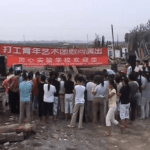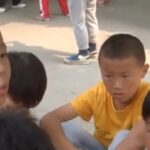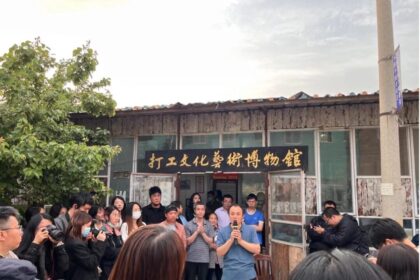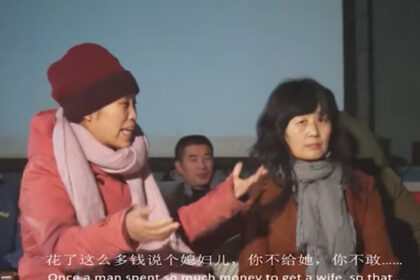Picun in Perspectives: An Introduction
Wei Wu
In 2022, Yuxiang Dong published “Repoliticizing the depoliticized: social practices of new workers in Picun” in Socially Engaged Public Art in East Asia: Space, Place, and Community in Action, edited by Meiqin Wang with a foreword from Grant Kester [1]. Focusing on the activities of migrant workers in Picun, a village in Beijing’s rural-urban fringes, Dong interrogates what it means to claim a collective identity for workers in a post-socialist China where class politics and struggle no longer govern people’s social or political life, and how that identity could be constructed. The multitude of historical and theoretical complexities surrounding the term “worker class” that Dong touched upon inspired the FIELD editorial collective to dedicate a special issue on Picun and the organizations and relationships established in and around this small village, as an opportunity to examine the fraught relationships between artists, intellectuals, and workers, as well as the different challenges they each face in crafting a worker-centered discourse and practice in contemporary China.
This special issue comes to fruition through the collective effort of three co-editors, two guest editors Yuxiang Dong and Yanhua Zhou, and Wei Wu from the FIELD editorial collective. Scholarly critiques are complemented by immediate on-site experiences, and contemporary problems are contextualized as historical concerns.
Yuxiang Dong’s essay traces the evolution of two interconnected groups, the New Workers Band and the Migrant Workers Home, and contextualizes their activities within the broader migrant worker community in Picun, situated on the outskirts of Beijing. Examining the two groups as case studies in a unique social, political, and historical environment instead of representative symptoms of an orthodoxically defined socialist revolution, Dong opens up the space to embrace alternative conceptions of a worker-centered revolution and forms of collective actions.
The four interviews are conducted with individuals from diverse social backgrounds who have interacted with the Migrant Workers Home in different ways [2]. From founders and volunteers serving the establishment to intellectual allies invested in its well-being, their perspectives provide insight into the social, political, and cultural challenges encountered by a worker-centered organization operating in contemporary China, as well as the merits and limitations of the Migrant Workers Home itself.
The three articles by Kuo Jia, Wei Wu, and Yanhua Zhou, further elucidate the distinctiveness and significance of the Picun-based worker community. Student-worker alliance has been a prominent component in labor movements. By focusing on a group of Chinese student activists who devoted themselves to the Jasic labor movement, a protest against the mistreatment of workers by the Shenzhen Jasic Technology Co., Ltd, Kuo Jia investigates how an official Marxism-Leninism-Maoism discourse influenced the mentality and activities of contemporary Chinese student activists and their definition of a socialist revolution [3]. Yanhua Zhou, on the other hand, examines the development of socially engaged art criticism in China. Building upon Lydia Liu’s notion of a “translingual practice,” Zhou compares and contrasts the strategies adopted by Chinese intellectuals and art professionals to transform a Western-centric discourse into a local context. Wei Wu’s historical survey of the various attempts to develop workers’ art in Maoist China uncovers how the CCP’s definition of the worker class changed over time and eventually led to the resolution of the “worker” as a distinctive class identity. The tensions exposed in this history, for instance, the foundation of a worker’s class identity and the significance of art activities to a worker community, remain relevant in the discussion of worker’s culture in post-socialist China.
Wei Wu is Ph.D. Candidate in the History of Art at the University of California, San Diego. Her research focuses on modern and contemporary Chinese art, in particular Republican Chinese visual culture, print culture, and intellectual history. Her dissertation investigates how Republican woodcut artists formed and articulated their understandings of the public and the nation through their works.
Notes
[1] Meiqin Wang, Socially Engaged Art in Contemporary China: Voices from Below (New York: Routledge, 2019).
[2] The four interviews were initially conducted in Chinese, primarily by Yuxiang Dong and Yanhua Zhou, and translated into English by Ningxin Chen from the Sichuan Fine Arts Institute. The translations have observed the following strategies. First of all, all the interviews are freely translated to keep the flow of each sentence, and adjustments are made after English syntax. Secondly, proper nouns, such as locations, are not translated verbatim but transliterated with Chinese pinyin to preserve their integrity. People’s family name also comes before their given name. Finally, Chinese characters are added to critical terms, artwork titles, art collectives, and NGOs, for readers who may want to conduct further research.
[3] Kuo Jia has also written about the Migrant Workers Home in 2017. See Kuo Jia, “Migrant Workers Home and its practices on shaping the culture and community of ‘New Working Class’: a criticism on cultural-political activism in contemporary China,” Cultural Studies, 31:6 (2017): 941-967.











